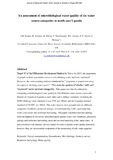JavaScript is disabled for your browser. Some features of this site may not work without it.
| dc.contributor.author | Parker, Alison | - |
| dc.contributor.author | Youlten, R. | - |
| dc.contributor.author | Dillon, M. | - |
| dc.contributor.author | Nussbaumer, T. | - |
| dc.contributor.author | Carter, Richard C. | - |
| dc.contributor.author | Tyrrel, Sean F. | - |
| dc.contributor.author | Webster, James | - |
| dc.date.accessioned | 2014-08-13T04:00:44Z | |
| dc.date.available | 2014-08-13T04:00:44Z | |
| dc.date.issued | 2010-12-31T00:00:00Z | - |
| dc.identifier.citation | A. H. Parker, R. Youlten, M. Dillon, T. Nussbaumer, R. C. Carter, S. F. Tyrrel and J. Webster, An assessment of microbiological water quality of six water source categories in north-east Uganda, Journal of Water and Health, 2010, Volume 08, Number 3, Pages 550–560. | |
| dc.identifier.issn | 1477-8920 | - |
| dc.identifier.uri | http://dx.doi.org/10.2166/wh.2010.128 | - |
| dc.identifier.uri | http://dspace.lib.cranfield.ac.uk/handle/1826/8639 | |
| dc.description.abstract | Target 7C of the Millennium Development Goals is to "halve, by 2015, the proportion of people without sustainable access to safe drinking water and basic sanitation". However, the corresponding indicator measures the "proportion of population using an improved drinking water source". This raises the question of whether "safe" and "improved" can be used interchangeably. This paper tests this hypothesis by comparing microbiological water quality in 346 different water sources across the District of Amuria in Uganda to each other and to defined standards, including the WHO drinking water standard of zero TTC per 100ml, and the Ugandan national standard of 50TTC per 100ml. The water sources were grouped into six different categories: boreholes, protected springs, covered hand dug wells, open hand dug wells, open water and roofwater harvesting. The paper concludes that the ranking from the highest to the lowest microbiological quality water was: boreholes, protected springs and roofwater harvesting, open and covered hand dug wells, open water. It also concludes that sanitary surveys cannot be used to predict water quality precisely; however they are an essential component of the monitoring of safe water supplies. | en_UK |
| dc.publisher | Iwa Publishing | en_UK |
| dc.rights | ©IWA Publishing 2010. The definitive peer-reviewed and edited version of this article is published in Journal of Water and Health, Volume 8, Issue 3, Pages 550-560, 2010 10.2166/wh.2010.128 and is available at www.iwapublishing.com | |
| dc.title | An assessment of microbiological water quality of six water source categories in north-east Uganda | en_UK |
| dc.type | Article | - |
Files in this item
This item appears in the following Collection(s)
-
Staff publications (SAS) [907]
